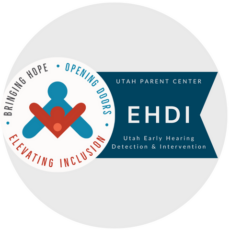
Infant & Pediatric Hearing Assessments
After a child has failed the hearing screening process and completed cytomegalovirus (CMV) testing*, a caregiver may have many questions. The next step is to complete a comprehensive hearing test with a pediatric audiologist as soon as possible, but before 3 months of age. Early detection of hearing differences is crucial to ensuring appropriate language access and development.
Receiving an accurate and timely diagnosis is a critical next step to providing early language access. A pediatric audiologist is someone with expertise in testing infants and children, specializing in early identification and management of pediatric hearing loss.
Infant and pediatric hearing assessment provides detailed information about a child’s hearing levels. The results may show they have typical hearing. However, if hearing loss is present, this testing will answer questions such as: How much can my child hear? Is it one or both ears? Is it permanent? Do they need early intervention services? Does my child need hearing aids or are there other strategies to give my child language access?
What to expect at a diagnostic appointment:
At the first appointment, audiologists will ask questions about a child’s newborn hearing screening and CMV results, developmental milestones, medical diagnoses, and family history. None of the following tests are painful, but will provide a complete picture about the auditory, or hearing, system. Sometimes multiple appointments may be necessary to complete the necessary tests.
Infants (< 6 months of age), and children unable to reliably test in a sound booth, will have an Auditory Brainstem Response or ABR test to determine the softest sounds they can hear at all of the frequencies (pitches) important for speech, called thresholds. The audiologist will place electrodes on the head to record how their brain responds to sounds. This test requires the baby to sleep for up to 2 hours.
As children develop, they begin to turn to find sounds they hear. This is a behavioral response and called behavioral testing when used in a sound booth, which is a sound-treated room. Audiologists will use this learned skill to watch how a child responds to sounds in the sound booth. When a child turns to the sound, the audiologist will activate a toy to reinforce their response and keep the child’s interest. This is called Visual Reinforcement Audiometry or VRA. VRA is typically used from 6 months of age – 2 ½ years of age.
As a child develops, they lose interest in VRA testing, needing a more difficult task to keep their attention. At this point, an audiologist will use an audiometer, place headphones on the child’s ears and utilize quiet games while they search for a threshold response. The child will listen for a sound and complete a task (reinforcement), such as putting the ball in a bucket when they hear a sound. This is called Conditioned Play Audiometry or CPA. This method is utilized from 2-5 years of age.
Children who are 5 years and older (developmentally) can usually start raising their hands or clapping when they hear the beep or sound in the headphones. This test is called Pure Tone Audiometry.
Other important tests in a complete hearing assessment include objective measures such as tympanometry and otoacoustic emissions or OAEs. Tympanometry measures how well the eardrum is moving; if the eardrum isn’t moving well, there is likely fluid in the middle ear space. OAEs measure how the cochlea, the hearing organ, is functioning. For both of these tests, a soft earplug is placed in the child’s ear to measure a response.
For more information visit familyhealth.utah.gov/ehdi or email ehdi@utah.gov.
*For reference, please see the previous article, Early Hearing Detection and Intervention Part 1: Newborn Hearing Screening and Congenital Cytomegalovirus.
World Hearing Day is on March 3rd, 2024. If you would like more information, go to https://www.who.int/campaigns/world-hearing-day






